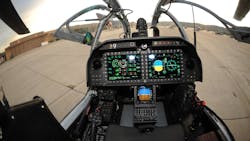Lockheed Martin to build electro-optical targeting systems for Bahrain, Czech Republic attack helicopters
PATUXENT RIVER NAS, Md. – Electro-optics experts at Lockheed Martin Corp. are building 19 multi-sensor electro-optical and infrared (EO/IR) fire-control systems for AH-1Z Viper attack helicopters that operate for Bahrain and the Czech Republic.
Officials of the Naval Air Systems Command at Patuxent River Naval Air Station, Md., announced an $49.7 million order on Wednesday to the Lockheed Martin Missiles and Fire Control segment in Orlando, Fla., for 19 AN/AAQ-30 target sight systems (TSS).
The TSS equipment for Viper helicopter gunships is part of the H-1 upgrades program for the remanufacture of legacy aircraft with state-of-the-art designs to convert existing AH-1W SuperCobra attack helicopters to the AH-1Z Viper, Navy officials say. The U.S. Marine Corps also operates the Viper attack helicopter.
The Lockheed Martin AN/AAQ-30 TSS provides target identification and tracking, passive targeting for integrated weapons -- including Hellfire missiles -- and a laser designation for laser-guided weapons. TSS provides can identify and laser-designate targets at the maximum ranges of Viper helicopter weapons.
The AN/AAQ-30 targeting system is a large-aperture midwave forward-looking infrared (FLIR) sensor, color TV, laser designator and rangefinder (with eyesafe mode), and on-gimbal inertial measurement unit integrated into a stabilized turret on the nose of the helicopter.
The AN/AAQ-30 has an 8.55-inch aperture, midwave staring FLIR with four fields-of-view for image resolution and long-range performance. Its gimbal is stabilized to less than 15 microradians.
The sensor suite has a multi-mode, multi-target tracker with coast-through-obscuration capability; on-gimbal inertial measurement unit for reduced image blur from jitter; precise line pointing; and target geo-location.
The sensor also has advanced image processing for sharp imagery; algorithms for enhanced image recognition and identification; high magnification; continuous zoom; and color TV with field-of-view matched to the FLIR.
The AN/AAQ-30 also has a cooled 640-by-512-pixel indium antimonide detector, as well as a modular architecture for future growth, Lockheed Martin officials say.
On this order Lockheed Martin will do the work in Orlando and Ocala, Fla.; Burlington, Ontario; Merrimack, N.H.; Santa Barbara, Calif., and other locations within the continental U.S., and should be finished by January 2023.
For more information contact Lockheed Martin Missiles and Fire Control online at www.lockheedmartin.com, or Naval Air Systems Command at www.navair.navy.mil.

John Keller | Editor-in-Chief
John Keller is the Editor-in-Chief, Military & Aerospace Electronics Magazine--provides extensive coverage and analysis of enabling electronics and optoelectronic technologies in military, space and commercial aviation applications. John has been a member of the Military & Aerospace Electronics staff since 1989 and chief editor since 1995.

